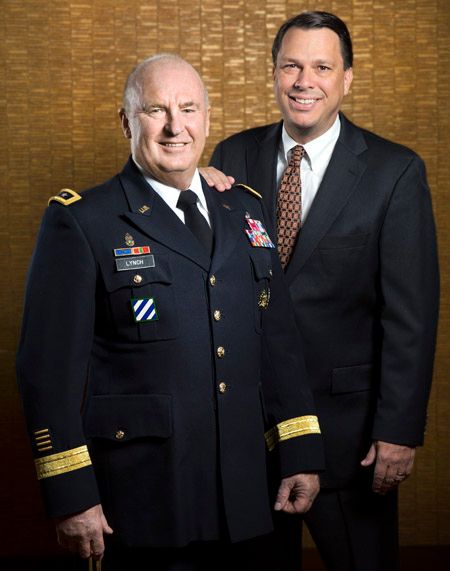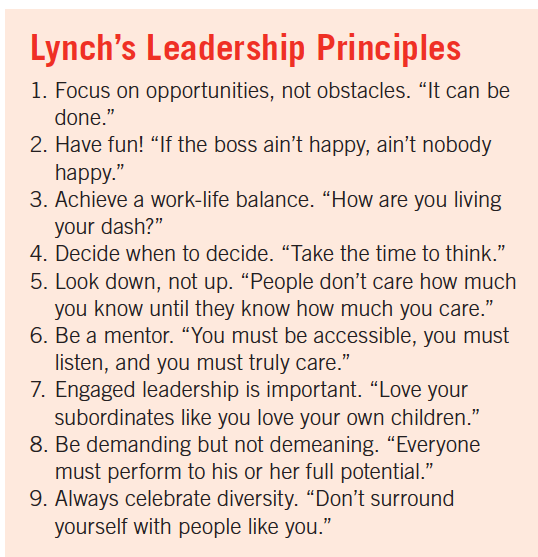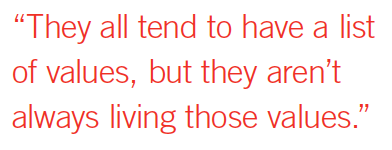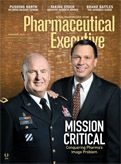Pharma's Image Fix: Lessons from the Field
Pharmaceutical Executive
Pharm Exec chronicles the military-industry effort to instill the principles of adaptive leadership into today’s pharma leader-a C-suite must in reviving the industry’s beleaguered reputation.
The importance of an "adaptive" command style in pharma today
Lieutenant General (Ret) Rick Lynch, US Army and Bob Jansen, CEO of Zensights, Pharm Exec Editorial Advisory Board member, and former president and general manager of Source Healthcare Analytics, a Symphony Technology Company (formerly Wolters Kluwer), met at a leadership center in 2009. At the time, Jansen was with Wolters Kluwer and Lynch was commanding the US Army’s Installation Management Command (IMCOM) responsible for all 163 Army installations. At the center, the two discovered they were kindred spirits separated only by a decade, different professional backgrounds, and dissimilar educational direction. But no matter. As Jansen says, “One night, we got to talking and Rick said to me ‘Why does the pharmaceutical industry have such a poor reputation?’ Then he began to wax poetically about the
Lt. Gen. (Ret) Rick Lynch, US Army, and Bob Jansen, CEO of Zensights (Photo: John Halpern). A special thanks to Tony Alicea, Philadelphia Marriott Downtown.

pharmaceutical industry and what a strategic advantage it is for the United States and the free world, and how the products developed by the pharmaceutical industry saved the lives of our men and women in uniform.”
Jansen explained that 99+% of people in the industry, he believes, are committed to continuing to develop breakthrough therapies to prolong and improve patients’ quality of life. Jansen said, “And I’m very proud to be a part of the industry-but you have the 1% that come in and take advantage of the pricing inelasticity of the products.” Lynch pointed out that the US Army post-Vietnam had an image problem as well. After American soldiers returned from war with visible and invisible wounds, the public turned its back on them, Lynch said. He told Jansen that the only way the pharma industry could change its public perception would be the way the military addressed the issue: by developing adaptive leaders with strong moral compasses. The other challenge discussed for the US military and pharma industry alike is the belief that the press wants to focus on negatives-the mentality of “If it bleeds, it leads”-discouraging coverage of the good things that come from those sectors.
Lynch and Jansen left the leadership center as good friends. Lynch retired from active duty on Jan. 1, 2012, and proceeded to write his first book, Adapt or Die, Battle-Tested Principles for Leaders, released in 2013. The book is an interesting and educational look at Lynch’s life, chronicling the challenges he experienced and the insights gleaned as he rose the ranks in the Army. The book spans his years in the US Military Academy, to a Master’s Degree in Mechanical Engineering from MIT, to command of the Marne Division and Fort Stewart/Hunter Army Airfield, to Commander Third Infantry Division and MultiNational Division Center in Iraq from June 2006 to July 2008, Commander III Corps and Fort Hood July 2008 to November 2009, and Commander Installation Management Command and assistant chief of staff for installation management from November 2009 to November 2011.
Jansen, meanwhile, left Wolters Kluwer/Symphony and using his extensive experience in pharma, founded Zensights in December 2012 to help biopharma leaders identify “best-in-class” vendors and further create meaningful engagement and partnerships between pharma companies and their strategic vendors.
Lynch began speaking engagements and corporate strategy advising across all industries. But Jansen wanted to bring his friend’s expertise on leadership directly to a changing biopharma industry. As Lynch told Pharm Exec, “We asked ourselves how we could improve leadership in the healthcare industry. What could we do to help develop more effective, compassionate, concerned, and caring leaders within the healthcare industry.”
Thus the brainchild of the “Adapt or Die” series of meetings. Through both of their contacts and networks, Lynch and Jansen launched Adapt or Die in 2014 to a smaller, focused executive audience to spread the word of the importance of developing adaptive leaders in the pharma industry that have strong moral compasses. The goal was to introduce these pharma leaders to military leaders who had already been involved in developing adaptable leaders, to share their playbook. Military leaders such as former commander-in-chief and president George W. Bush; former secretary of the Army, George Casey; General Fred Franks; General Ben Griffin; secretary of the VA, David Shulkin; and Lt. General Butch Funk have been speakers at these meetings.
The goal may sound lofty, but the meetings have been well-received over the years, and have gained traction with their audience. The list of speakers from pharma who have shared their experiences is impressive. They include Alex Gorsky, chairman and CEO of Johnson & Johnson; Bob Oliver, chairman of Otsuka Pharmaceuticals Canada; Sandy Costas, former president and chief operating officer of Quintiles; Dr. Sandra Milligan, senior vice president and head of global regulatory affairs and clinical safety for Merck & Co.; Mark Alles, CEO of Celgene; Perry Sternberg, head of US commercial, Shire Pharmaceuticals; Ramona Sequeira, president, Takeda Pharmaceuticals USA; Jay Galeota, president and chief operating officer, G&W Laboratories; John Arena, vice president and general manager, US psychiatry, Lundbeck; Victor Vaughn, senior VP of sales and marketing, Supernus Pharmaceuticals; Jack Bailey, president of the Americas for GlaxoSmithKline; and Murdo Gordon, chief commercial officer, Bristol-Myers Squibb.
“Pharma is based on a premise that is innovation-driven, which, by definition, means disruptive,” said Galeota. “We tend to think of disruption as agile and fast, but in the case of the pharma industry, many enterprises are more like institutions, and they move slowly; new drug development takes time and care. Ironically, pharmaceutical companies willingly take on risk with development programs, yet are slow to take on risk in other areas like business model evolution, for example. There is a kind of dichotomy; on one hand, there is an appetite for investing heavily in unproven new programs in the labs, but on the other, very little tolerance for novel approaches to how companies are run, go to market, price products, etc.”
To that end, Galeota explained that the idea of constant adaptation in order to stay ahead is critical for pharma leaders to understand and, ideally, embrace. “Yet it seems to happen rarely, unless forced,” he said, noting the need for current and up-and-coming pharma leaders to consider adaptive leadership principles.
While no one would dispute that the biopharma industry is full of smart, educated, and successful individuals, the skills and ideologies necessary to take the risk-averse industry to a new and necessary level in a shortened timeframe is not lost on many.
Consider the following challenges facing the pharma C-suite:
- Pharma R&D ROI is currently below the cost of capital, and projected to be zero by 2020.1
- 2019 represents the pinnacle of the decline for pharma sales over the next 20 years.1
- Sales at risk worth $194 billion potentially signal a second patent cliff era with the advent of biosimilars.2
- Four-fifths of US health insurers require evidence of cost savings or a clear clinical benefit to include new therapies on their formularies. A further 16% have entered into outcomes-based contracts, while another 33% expect to do so within three years.3
Jack Hammond, Brigadier General (Ret), US Army, executive director of Home Base, A Red Sox Foundation and Massachusetts General Hospital program, and a former speaker for Adapt or Die, says, “The whole philosophy of adapt or die is you have to change with the times, and if you don’t, you do it at your own peril.”
What good leadership looks like
In Lynch’s book, he elaborates on his nine leadership principles, and each of the meetings has tackled a specific topic so attendees could leave with a better appreciation of an aspect of leadership. Those topics to date have included values-based leadership; corporate social responsibility; ethical and strategic decision-making; innovative partnerships; and the latest in December on mentorship.

Much of Lynch’s book includes what some people would think is common sense. Follow the Golden Rule-treat people the way you want to be treated. Walk the walk. Leaders should look down, not up. Do every job superbly. Be sure that people know you are doing a good job. But in the book, and at the Adapt or Die meetings, Lynch shares examples of poor leadership and how he started to keep a booklet of what not to do when he became a leader.
Lynch says, “In my executive coaching and strategic planning for corporate America, they all tend to have a list of values, but they aren’t always living those values. They are not always demonstrating those values, and that’s very important.”
Galeota said the first time he was introduced to an Adapt or Die meeting, it was on the subject of character. “That caught my eye because it was the first time in my career I’d seen a program dedicated to the topic of character in the business setting,” he says. “When I went through military training, there was a lot of emphasis around character, but it has been not a marquee topic in the business sector.”
As noted, Galeota has a military background and completed four years in the US Air Force Reserve Officer Training Corps. J&J’s Gorsky attended West Point, graduated and was commissioned as a 2nd Lieutenant in Field Artillery and later completed Airborne School. Merck’s Milligan was a general medical officer in the Army and Celgene's Alles a captain in the Marine Corps.
In Pharm Exec’s most recent Emerging Pharma Leaders issue, two of the leaders profiled have served. Whether or not that is a hallmark of inspired leaders or people who want to continue to contribute, Hammond says, “There are skill sets in the military that translate into good executive leaders. Number one, we institute a very strong moral compass, as this is crucial based upon the type of work we do. Our leaders operate on their own in austere conditions, and have to use their best judgement. If they make bad choices, really bad things can happen and people can die. So we develop a heavily mandated values system which becomes ingrained in them.
“We strive to build agile and adaptive leaders that are good at thinking on their feet and developing a good decision-making process that is well thought out-not just gut hunches,” Hammond continued. “They are taught to listen to a variety of people prior to making decisions. Our leaders are trained and constantly reminded to take care of our people, as our soldiers drive success. There is nothing unique to this thinking other than the fact it has been effectively put into practice within the military. I am confident that these are values and practices you would look for in the civilian world as well.”
Galeota explained further: “I continue to be struck by the fact that almost independent of mission, whether you are in private enterprise, or government or philanthropy, or a military organization, once you get to a certain level of leadership, the challenges are almost identical and they center primarily around the people-related aspects to running large organizations…how to communicate effectively and efficiently, how to create an environment of engagement, an environment that has high standards, and motivates people to reach for those standards with character, courage, and humility. These kinds of challenges, which are common across all those

groups, are brought forward in Adapt or Die.”
Lynch and Jansen said about 400 executives in the healthcare arena have attended their series. Lynch continues to believe that adaptive leadership will help companies in any industry respond more successfully to the changes around them. Specifically, for pharma leaders, Lynch says the meetings “challenge the norms and puts life in perspective for these incredibly accomplished leaders, and I do believe these meetings will transcend for these people that attend so that the public understands the value of the pharmaceutical industry.” Both Lynch and Jansen have received feedback from attendees who say they have learned valuable lessons, have looked at their behavior, and made changes when they returned to their respective organizations.
Lynch concludes: “We have lots more people to touch. And some people slip back into bad behavior and you have to remind them what we talked about.”
Adapt or Die, 2018
Gettysburg, PA, and Normandy Beach, France, will be the settings this year. “Leadership Under Fire” will focus on the challenges that pharma leaders face, followed by a walk through the battlefields with historians who will describe what crises the respective generals faced. Jansen and Lynch describe: “Pharma leaders may be facing their own pressures, but it’s okay to make the right choice and not take the path of least resistance. Nobody is firing a gun at you; they aren’t easy decisions, but they aren’t life and death. But you could make the decisions that are right by your people, which will positively affect the industry.”
Lisa Henderson is Pharm Exec’s Editor-in-Chief. She can be reached at lisa.henderson@ubm.com
References
1. https://endpts.com/pharmas-broken-business-model-an-industry-on-the-brink-of-terminal-decline/
2. http://info.evaluategroup.com/rs/607-YGS-364/images/WP17.pdf
3.
https://www.pwc.com/gx/en/pharma-life-sciences/pharma2020/assets/pwc-pharma-success-strategies.pdf
Addressing Disparities in Psoriasis Trials: Takeda's Strategies for Inclusivity in Clinical Research
April 14th 2025LaShell Robinson, Head of Global Feasibility and Trial Equity at Takeda, speaks about the company's strategies to engage patients in underrepresented populations in its phase III psoriasis trials.